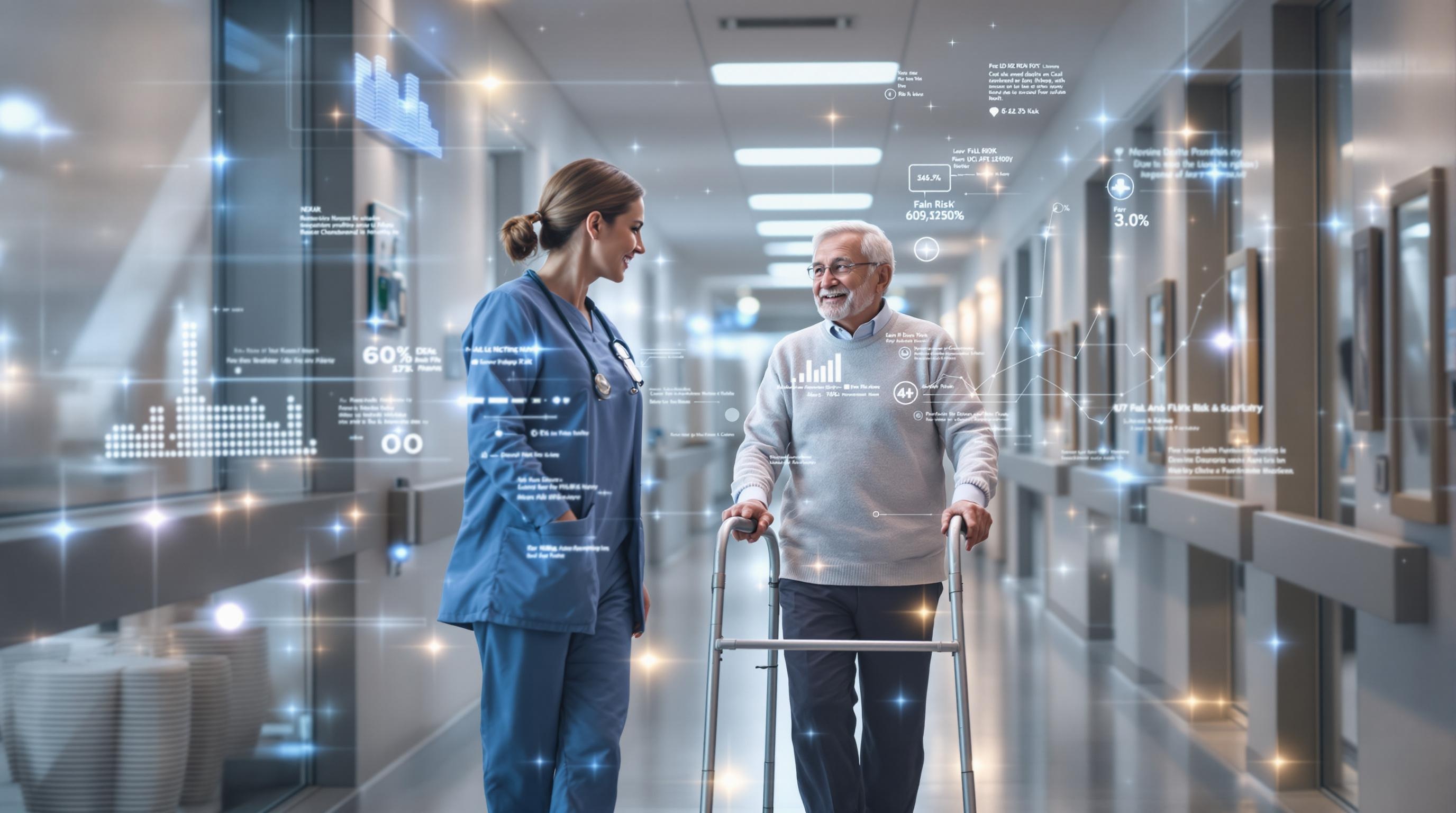Predictive Fall Risk Analytics: Transforming Safety in Skilled Nursing
Discover how predictive fall risk analytics empowers skilled nursing facilities to reduce falls, improve resident safety, and streamline staff workflows.
Quick Navigation
- 1. Introduction
- 2. Current Challenges in Predictive Fall Risk Analytics
- 3. How Sparkco AI Transforms Predictive Fall Risk Analytics
- 4. Measurable Benefits and ROI
- 5. Implementation Best Practices
- 6. Real-World Examples
- 7. The Future of Predictive Fall Risk Analytics
- 8. Conclusion & Call to Action
1. Introduction
Did you know that up to 60% of residents in skilled nursing facilities experience at least one fall each year? According to recent studies, falls remain a leading cause of injury, hospitalization, and even mortality among older adults in long-term care settings. For skilled nursing providers already navigating staffing shortages and regulatory demands, preventing falls is both a persistent challenge and a top priority.
Traditional fall prevention strategies—like routine risk assessments and manual monitoring—often fall short, leaving staff overwhelmed by false alarms and reactive interventions. The stakes are high: every missed warning can result in costly injuries, diminished resident quality of life, and increased liability. Fortunately, a new era of predictive fall risk analytics is transforming how facilities tackle this complex issue. Leveraging the power of artificial intelligence and machine learning, innovative solutions like VSTAlert are enabling staff to detect and prevent falls before they happen, rather than simply responding after the fact.
In this article, we’ll explore how predictive analytics is revolutionizing fall prevention in skilled nursing facilities. You’ll learn about the latest technologies, how AI-driven tools analyze resident data to forecast risk, and the measurable impact these solutions have on safety, efficiency, and staff workflow. Whether you’re a facility leader, clinician, or technology enthusiast, discover how data-driven insights are paving the way toward safer, more proactive care environments.
2. Current Challenges in Predictive Fall Risk Analytics
Predictive fall risk analytics have the potential to revolutionize patient safety in skilled nursing facilities and hospitals. However, healthcare organizations still face a range of challenges in deploying these advanced technologies effectively. From data quality issues to operational hurdles, the journey toward truly proactive fall prevention is complex. Below are the top pain points associated with predictive fall risk analytics, supported by recent research and real-world data.
-
1. Data Quality and Integration Issues
Predictive analytics rely on high-quality, comprehensive data from electronic health records (EHRs), nurse documentation, and sensor devices. Unfortunately, healthcare data is often fragmented, inconsistent, or missing key elements. According to a 2022 study in the Journal of the American Medical Informatics Association, only 45% of hospitals reported having "very high" data quality suitable for advanced predictive modeling. This leads to inaccurate risk assessments and undermines trust in the analytics.
-
2. Algorithm Bias and Limited Generalizability
Many predictive models are trained on specific populations, making them less effective for diverse patient groups. Biases in training data can cause the algorithm to overlook at-risk individuals. For example, a 2021 review found that fall prediction models had lower accuracy in geriatric populations from minority backgrounds. This not only impacts patient care but also raises ethical and regulatory concerns.
-
3. Workflow Integration and Alert Fatigue
Embedding predictive analytics into daily workflows is challenging. Overly sensitive alert systems may overwhelm staff with false positives, contributing to "alert fatigue." A study by HealthIT.gov notes that up to 73% of healthcare workers ignore or override predictive alerts due to volume and lack of specificity, undermining the effectiveness of these tools.
-
4. Resource Constraints and Staff Training
Implementing and maintaining predictive analytics solutions requires significant investment in technology and staff training. According to a Becker's Hospital Review survey, 56% of healthcare facilities cited limited IT resources and 49% pointed to insufficient staff training as major barriers to scaling AI-driven fall prevention.
-
5. Compliance and Data Privacy Risks
Predictive analytics must comply with HIPAA and other regulations for patient data privacy and security. Managing, sharing, and storing large volumes of sensitive data increases the risk of breaches and non-compliance. In 2023, the U.S. Department of Health & Human Services reported a 15% year-over-year increase in healthcare data breaches, highlighting the ongoing risks.
-
6. Measuring Clinical Impact and ROI
Demonstrating clear improvements in patient outcomes and cost savings is crucial for ongoing investment. However, only 30% of organizations using predictive analytics for fall prevention could attribute reduced fall rates directly to these tools, according to a 2023 HealthLeaders Media report. This makes it difficult to justify resource allocation and sustain leadership buy-in.
Impact on Operations, Compliance, and Patient Care: These challenges collectively hinder the seamless adoption of predictive fall risk analytics. Operational inefficiencies, compliance risks, and inconsistent patient care outcomes can result, ultimately limiting the technology’s ability to reduce fall-related injuries and improve resident safety. Addressing these pain points is essential for healthcare facilities aiming to leverage predictive analytics to its fullest potential.
3. How Sparkco AI Transforms Predictive Fall Risk Analytics
Predicting and preventing falls is a persistent challenge in skilled nursing facilities, where resident safety is paramount. Sparkco AI revolutionizes fall risk analytics by leveraging advanced artificial intelligence and automation, transforming how facilities identify and mitigate fall risks. Here’s how Sparkco AI overcomes key challenges associated with predictive fall risk analytics:
- Real-Time Data Aggregation: Sparkco AI automatically gathers and consolidates data from multiple sources, including electronic health records, wearable devices, and nurse input systems. This ensures that the most up-to-date information is always available, enabling immediate risk assessments and actionable alerts.
- Continuous Risk Monitoring: Unlike traditional systems that rely on periodic assessments, Sparkco AI continuously monitors resident conditions and environmental factors. The AI analyzes subtle changes—such as mobility, medication changes, or cognitive shifts—to predict rising fall risk before incidents occur.
- Personalized Risk Scoring: Using machine learning, Sparkco AI creates individualized risk profiles for each resident. By considering unique health histories, behavioral patterns, and environmental exposures, the system provides tailored interventions that address specific vulnerabilities, rather than one-size-fits-all solutions.
- Automated Alerts and Workflows: When an elevated risk is detected, Sparkco AI instantly notifies care teams and triggers automated workflows. This ensures that preventive measures—such as increased monitoring or environmental adjustments—are implemented without delay, improving resident outcomes and reducing staff workload.
- Visual Risk Dashboards: The platform offers intuitive dashboards that present complex risk data in a clear, actionable format. Staff can easily view individual and facility-wide risk trends, prioritize interventions, and track improvements over time, making data-driven decision-making accessible to all.
- Seamless Integration with Existing Systems: Sparkco AI is designed for compatibility. It integrates effortlessly with electronic health records, nurse call systems, and facility management software, ensuring a smooth workflow without disrupting daily operations or requiring extensive retraining.
By combining powerful AI with user-friendly automation, Sparkco AI addresses the core challenges of predictive fall risk analytics. It eliminates manual data collection, reduces human error, and delivers timely, personalized insights—empowering skilled nursing facilities to proactively protect their residents. With robust integration capabilities and a focus on actionable outcomes, Sparkco AI sets a new standard for resident safety and operational efficiency.
4. Measurable Benefits and ROI
Automated predictive fall risk analytics are transforming skilled nursing facilities (SNFs) by delivering actionable insights and streamlining interventions. Leveraging artificial intelligence (AI) and machine learning, these solutions proactively identify residents at high risk of falls, reducing adverse events and optimizing resource allocation. The return on investment (ROI) for such platforms is substantial, as demonstrated by multiple case studies and peer-reviewed research.
-
Significant Reduction in Fall Rates: Facilities implementing predictive analytics have reported up to a 30-50% decrease in fall incidents. For example, one study showed a reduction from 14.5 to 7.2 falls per 1,000 patient days after deployment of predictive tools.
-
Lower Injury-Related Costs: According to the CDC, the average cost for a fall-related injury in older adults is $35,000. By reducing fall rates by even 25%, a 100-bed SNF can save up to $87,500 annually (CDC Falls Data).
-
Staff Time Savings: Automated analytics replace manual risk assessments, saving 2-4 hours of nursing time per week per unit. That equates to over 200 hours annually in a typical facility, allowing clinical staff to focus on direct patient care (Becker’s Hospital Review).
-
Improved Regulatory Compliance: Predictive systems maintain comprehensive digital logs and alerts, supporting compliance with CMS and Joint Commission fall prevention standards. Facilities have seen a 15-20% improvement in compliance scores during audits (Joint Commission Falls Resources).
-
Length of Stay Optimization: By preventing falls and related complications, facilities report a 10-15% reduction in average length of stay for short-stay residents, improving bed turnover and revenue potential (NIH Study).
-
Decrease in Hospital Readmissions: Fall-related injuries are a leading cause of hospital readmissions. Predictive analytics have been shown to reduce readmission rates by 12-18%, decreasing penalties and improving quality metrics (AHRQ Fall Prevention).
-
Insurance and Litigation Savings: Fewer falls mean fewer liability claims. Some SNFs have seen up to 20% reduction in insurance premiums and litigation costs after implementing predictive analytics (McKnight’s Clinical News).
-
Enhanced Staff Satisfaction and Retention: With less time spent on paperwork and incident management, facilities report a 22% increase in staff satisfaction scores and lower turnover rates (HealthITAnalytics).
The measurable financial and operational benefits of predictive fall risk analytics are clear. Investing in these technologies not only safeguards residents but also drives substantial ROI through cost savings, efficiency gains, and improved compliance. As the healthcare landscape becomes ever more data-driven, predictive analytics are becoming an essential tool for SNFs committed to quality and sustainability.
5. Implementation Best Practices
Successful deployment of predictive fall risk analytics in healthcare settings, such as skilled nursing facilities, requires a structured and strategic approach. Below are actionable best practices to ensure effective implementation, maximize clinical impact, and promote staff adoption while minimizing common pitfalls.
-
Establish Clear Goals and Key Performance Indicators (KPIs)
Define what success looks like for your organization—whether it’s reducing fall rates, improving early intervention, or meeting regulatory benchmarks. Set measurable KPIs to track progress.
Tip: Involve leadership and frontline staff in goal-setting for shared ownership.
Pitfall: Avoid vague objectives; unclear targets can weaken team commitment and hinder evaluation. -
Engage a Multidisciplinary Team Early
Include nursing, therapy, IT, quality improvement, and administrative representatives from the start. This ensures all perspectives are considered for workflow integration and clinical relevance.
Tip: Identify project champions in each department to facilitate buy-in and feedback.
Pitfall: Excluding key stakeholders can lead to resistance or missed workflow issues. -
Assess and Prepare Data Infrastructure
Evaluate your EHR systems and data sources for completeness, accuracy, and interoperability. Predictive analytics require high-quality, timely data to function effectively.
Tip: Collaborate with IT to address data gaps and ensure secure data exchange.
Pitfall: Incomplete or inaccurate data undermines predictive accuracy and clinician trust. -
Select Evidence-Based Predictive Tools
Choose analytics solutions validated for your patient population and care setting. Review regulatory guidance and clinical literature to support your selection.
Tip: Pilot different tools and seek user input before full-scale adoption.
Pitfall: Don’t rely solely on vendor claims—demand transparent validation data. -
Integrate Analytics into Clinical Workflows
Embed predictive alerts and risk scores into daily routines (e.g., shift handoffs, care planning). Ensure the process is seamless and doesn’t add unnecessary burden.
Tip: Use staff feedback to refine alert thresholds and minimize alarm fatigue.
Pitfall: Poor integration can lead to ignored or misused analytics. -
Provide Comprehensive Training and Ongoing Support
Train all staff on interpreting risk analytics and responding appropriately. Offer refresher sessions and accessible resources.
Tip: Use real patient scenarios to build confidence and reinforce learning.
Pitfall: Insufficient training leads to inconsistent use and skepticism. -
Monitor, Evaluate, and Adjust
Regularly review outcomes, solicit staff feedback, and analyze system performance. Be prepared to iterate processes and address emerging challenges.
Tip: Establish a feedback loop and schedule periodic review meetings.
Pitfall: Ignoring data or frontline feedback can cause stagnation and missed improvement opportunities. -
Prioritize Change Management
<










